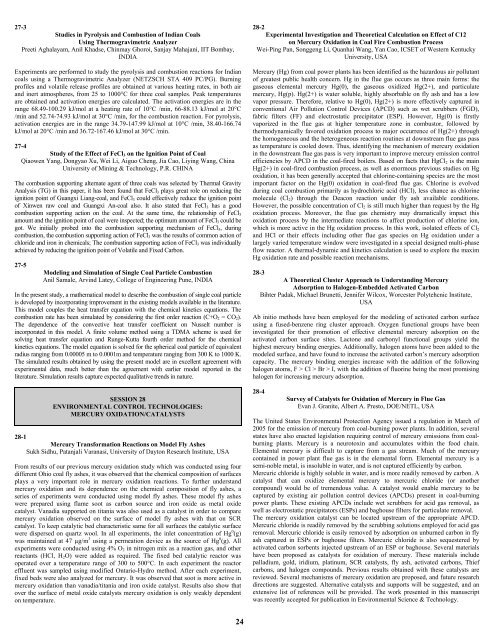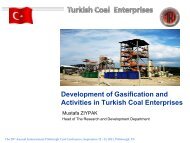Abstract Booklet 2006 - Swanson School of Engineering - University ...
Abstract Booklet 2006 - Swanson School of Engineering - University ...
Abstract Booklet 2006 - Swanson School of Engineering - University ...
Create successful ePaper yourself
Turn your PDF publications into a flip-book with our unique Google optimized e-Paper software.
27-3<br />
Studies in Pyrolysis and Combustion <strong>of</strong> Indian Coals<br />
Using Thermogravimetric Analyzer<br />
Preeti Aghalayam, Anil Khadse, Chinmay Ghoroi, Sanjay Mahajani, IIT Bombay,<br />
INDIA<br />
Experiments are performed to study the pyrolysis and combustion reactions for Indian<br />
coals using a Thermogravimetric Analyzer (NETZSCH STA 409 PC/PG). Burning<br />
pr<strong>of</strong>iles and volatile release pr<strong>of</strong>iles are obtained at various heating rates, in both air<br />
and inert atmospheres, from 25 to 1000°C for three coal samples. Peak temperatures<br />
are obtained and activation energies are calculated. The activation energies are in the<br />
range 68.49-100.29 kJ/mol at a heating rate <strong>of</strong> 10°C /min, 66-88.13 kJ/mol at 20°C<br />
/min and 52.74-74.93 kJ/mol at 30°C /min, for the combustion reaction. For pyrolysis,<br />
activation energies are in the range 34.79-147.99 kJ/mol at 10°C /min, 38.40-166.74<br />
kJ/mol at 20°C /min and 36.72-167.46 kJ/mol at 30°C /min.<br />
27-4<br />
Study <strong>of</strong> the Effect <strong>of</strong> FeCl 3 on the Ignition Point <strong>of</strong> Coal<br />
Qiaowen Yang, Dongyao Xu, Wei Li, Aiguo Cheng, Jia Cao, Liying Wang, China<br />
<strong>University</strong> <strong>of</strong> Mining & Technology, P.R. CHINA<br />
The combustion supporting alternate agent <strong>of</strong> three coals was selected by Thermal Gravity<br />
Analysis (TG) in this paper, it has been found that FeCl 3 plays great role on reducing the<br />
ignition point <strong>of</strong> Guangxi Liang-coal, and FeCl 3 could effectively reduce the ignition point<br />
<strong>of</strong> Xinwen raw coal and Guangxi An-coal also. It also stated that FeCl 3 has a good<br />
combustion supporting action on the coal. At the same time, the relationship <strong>of</strong> FeCl 3<br />
amount and the ignition point <strong>of</strong> coal were inspected; the optimum amount <strong>of</strong> FeCl 3 could be<br />
got. We initially probed into the combustion supporting mechanism <strong>of</strong> FeCl 3 , during<br />
combustion, the combustion supporting action <strong>of</strong> FeCl 3 was the results <strong>of</strong> common action <strong>of</strong><br />
chloride and iron in chemicals; The combustion supporting action <strong>of</strong> FeCl 3 was individually<br />
achieved by reducing the ignition point <strong>of</strong> Volatile and Fixed Carbon.<br />
27-5<br />
Modeling and Simulation <strong>of</strong> Single Coal Particle Combustion<br />
Anil Samale, Arvind Latey, College <strong>of</strong> <strong>Engineering</strong> Pune, INDIA<br />
In the present study, a mathematical model to describe the combustion <strong>of</strong> single coal particle<br />
is developed by incorporating improvement in the existing models available in the literature.<br />
This model couples the heat transfer equation with the chemical kinetics equations. The<br />
combustion rate has been simulated by considering the first order reaction (C+O 2 = CO 2 ).<br />
The dependence <strong>of</strong> the convective heat transfer coefficient on Nusselt number is<br />
incorporated in this model. A finite volume method using a TDMA scheme is used for<br />
solving heat transfer equation and Runge-Kutta fourth order method for the chemical<br />
kinetics equations. The model equation is solved for the spherical coal particle <strong>of</strong> equivalent<br />
radius ranging from 0.00005 m to 0.0001m and temperature ranging from 300 K to 1000 K.<br />
The simulated results obtained by using the present model are in excellent agreement with<br />
experimental data, much better than the agreement with earlier model reported in the<br />
literature. Simulation results capture expected qualitative trends in nature.<br />
SESSION 28<br />
ENVIRONMENTAL CONTROL TECHNOLOGIES:<br />
MERCURY OXIDATION/CATALYSTS<br />
28-1<br />
Mercury Transformation Reactions on Model Fly Ashes<br />
Sukh Sidhu, Patanjali Varanasi, <strong>University</strong> <strong>of</strong> Dayton Research Institute, USA<br />
From results <strong>of</strong> our previous mercury oxidation study which was conducted using four<br />
different Ohio coal fly ashes, it was observed that the chemical composition <strong>of</strong> surfaces<br />
plays a very important role in mercury oxidation reactions. To further understand<br />
mercury oxidation and its dependence on the chemical composition <strong>of</strong> fly ashes, a<br />
series <strong>of</strong> experiments were conducted using model fly ashes. These model fly ashes<br />
were prepared using flame soot as carbon source and iron oxide as metal oxide<br />
catalyst. Vanadia supported on titania was also used as a catalyst in order to compare<br />
mercury oxidation observed on the surface <strong>of</strong> model fly ashes with that on SCR<br />
catalyst. To keep catalytic bed characteristic same for all surfaces the catalytic surface<br />
were dispersed on quartz wool. In all experiments, the inlet concentration <strong>of</strong> Hg 0 (g)<br />
was maintained at 47 µg/m 3 using a permeation device as the source <strong>of</strong> Hg 0 (g). All<br />
experiments were conducted using 4% O 2 in nitrogen mix as a reaction gas, and other<br />
reactants (HCl, H 2 O) were added as required. The fixed bed catalytic reactor was<br />
operated over a temperature range <strong>of</strong> 300 to 500°C. In each experiment the reactor<br />
effluent was sampled using modified Ontario-Hydro method. After each experiment,<br />
fixed beds were also analyzed for mercury. It was observed that soot is more active in<br />
mercury oxidation than vanadia/titania and iron oxide catalyst. Results also show that<br />
over the surface <strong>of</strong> metal oxide catalysts mercury oxidation is only weakly dependent<br />
on temperature.<br />
28-2<br />
Experimental Investigation and Theoretical Calculation on Effect <strong>of</strong> C12<br />
on Mercury Oxidation in Coal Fire Combustion Process<br />
Wei-Ping Pan, Songgeng Li, Quanhai Wang, Yan Cao, ICSET <strong>of</strong> Western Kentucky<br />
<strong>University</strong>, USA<br />
Mercury (Hg) from coal power plants has been identified as the hazardous air pollutant<br />
<strong>of</strong> greatest public health concern. Hg in the flue gas occurs as three main forms: the<br />
gaseous elemental mercury Hg(0), the gaseous oxidized Hg(2+), and particulate<br />
mercury, Hg(p). Hg(2+) is water soluble, highly absorbable on fly ash and has a low<br />
vapor pressure. Therefore, relative to Hg(0), Hg(2+) is more effectively captured in<br />
conventional Air Pollution Control Devices (APCD) such as wet scrubbers (FGD),<br />
fabric filters (FF) and electrostatic precipitator (ESP). However, Hg(0) is firstly<br />
vaporized in the flue gas at higher temperature zone in combustor, followed by<br />
thermodynamically favored oxidation process to major occurrence <strong>of</strong> Hg(2+) through<br />
the homogeneous and the heterogeneous reaction routines at downstream flue gas pass<br />
as temperature is cooled down. Thus, identifying the mechanism <strong>of</strong> mercury oxidation<br />
in the downstream flue gas pass is very important to improve mercury emission control<br />
efficiencies by APCD in the coal-fired boilers. Based on facts that HgCl 2 is the main<br />
Hg(2+) in coal-fired combustion process, as well as enormous previous studies on Hg<br />
oxidation, it has been generally accepted that chlorine-containing species are the most<br />
important factor on the Hg(0) oxidation in coal-fired flue gas. Chlorine is evolved<br />
during coal combustion primarily as hydrochloric acid (HCl), less chance as chlorine<br />
molecule (Cl 2 ) through the Deacon reaction under fly ash available conditions.<br />
However, the possible concentration <strong>of</strong> Cl 2 is still much higher than request by the Hg<br />
oxidation process. Moreover, the flue gas chemistry may dramatically impact this<br />
oxidation process by the intermediate reactions to affect production <strong>of</strong> chlorine ion,<br />
which is more active in the Hg oxidation process. In this work, isolated effects <strong>of</strong> Cl 2<br />
and HCl or their effects including other flue gas species on Hg oxidation under a<br />
largely varied temperature window were investigated in a special designed multi-phase<br />
flow reactor. A thermal-dynamic and kinetics calculation is used to explore the maxim<br />
Hg oxidation rate and possible reaction mechanisms.<br />
28-3<br />
A Theoretical Cluster Approach to Understanding Mercury<br />
Adsorption to Halogen-Embedded Activated Carbon<br />
Bihter Padak, Michael Brunetti, Jennifer Wilcox, Worcester Polytehcnic Institute,<br />
USA<br />
Ab initio methods have been employed for the modeling <strong>of</strong> activated carbon surface<br />
using a fused-benzene ring cluster approach. Oxygen functional groups have been<br />
investigated for their promotion <strong>of</strong> effective elemental mercury adsorption on the<br />
activated carbon surface sites. Lactone and carbonyl functional groups yield the<br />
highest mercury binding energies. Additionally, halogen atoms have been added to the<br />
modeled surface, and have found to increase the activated carbon’s mercury adsorption<br />
capacity. The mercury binding energies increase with the addition <strong>of</strong> the following<br />
halogen atoms, F > Cl > Br > I, with the addition <strong>of</strong> fluorine being the most promising<br />
halogen for increasing mercury adsorption.<br />
28-4<br />
Survey <strong>of</strong> Catalysts for Oxidation <strong>of</strong> Mercury in Flue Gas<br />
Evan J. Granite, Albert A. Presto, DOE/NETL, USA<br />
The United States Environmental Protection Agency issued a regulation in March <strong>of</strong><br />
2005 for the emission <strong>of</strong> mercury from coal-burning power plants. In addition, several<br />
states have also enacted legislation requiring control <strong>of</strong> mercury emissions from coalburning<br />
plants. Mercury is a neurotoxin and accumulates within the food chain.<br />
Elemental mercury is difficult to capture from a gas stream. Much <strong>of</strong> the mercury<br />
contained in power plant flue gas is in the elemental form. Elemental mercury is a<br />
semi-noble metal, is insoluble in water, and is not captured efficiently by carbon.<br />
Mercuric chloride is highly soluble in water, and is more readily removed by carbon. A<br />
catalyst that can oxidize elemental mercury to mercuric chloride (or another<br />
compound) would be <strong>of</strong> tremendous value. A catalyst would enable mercury to be<br />
captured by existing air pollution control devices (APCDs) present in coal-burning<br />
power plants. These existing APCDs include wet scrubbers for acid gas removal, as<br />
well as electrostatic precipitators (ESPs) and baghouse filters for particulate removal.<br />
The mercury oxidation catalyst can be located upstream <strong>of</strong> the appropriate APCD.<br />
Mercuric chloride is readily removed by the scrubbing solutions employed for acid gas<br />
removal. Mercuric chloride is easily removed by adsorption on unburned carbon in fly<br />
ash captured in ESPs or baghouse filters. Mercuric chloride is also sequestered by<br />
activated carbon sorbents injected upstream <strong>of</strong> an ESP or baghouse. Several materials<br />
have been proposed as catalysts for oxidation <strong>of</strong> mercury. These materials include<br />
palladium, gold, iridium, platinum, SCR catalysts, fly ash, activated carbons, Thief<br />
carbons, and halogen compounds. Previous results obtained with these catalysts are<br />
reviewed. Several mechanisms <strong>of</strong> mercury oxidation are proposed, and future research<br />
directions are suggested. Alternative catalysts and supports will be suggested, and an<br />
extensive list <strong>of</strong> references will be provided. The work presented in this manuscript<br />
was recently accepted for publication in Environmental Science & Technology.<br />
24














